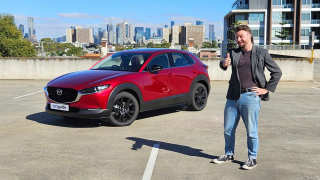
Mercedes-Benz Actros 2660 v Mercedes-Benz CLS-Class CLS 63
- Mercedes-Benz CLS-Class
- Mercedes-Benz CLS63
- Mercedes-Benz CLS-Class 2011
- Mercedes-Benz CLS63 2011
- Mercedes-Benz CLS-Class Reviews
- Mercedes-Benz CLS63 Reviews
- Mercedes-Benz Reviews
- Mercedes-Benz Sedan Range
- Sedan
- Mercedes-Benz
- Prestige & Luxury Cars
They cost a similar amount of money and have V8 engines, but there is still a world of difference between the Mercedes-Benz Actros and CLS 63 AMG. We are at Eastern Creek raceway just out of Sydney for the ultimate comparison between the premium truck and the extremely powerful four-door luxury cruiser.
Of course, the Actros is at home on the highway with a big load on the back, but we have brought it to a racetrack for a bit of fun to see how it compares against its smaller sibling without a trailer. In truckie talk, this is called running bobtail.
The CLS, which is big for a car but small compared to the Actros, is better suited to cruising country roads or navigating the city, but this is the hot AMG version which means it fairly handy on the track too.
It might seem ridiculous to compare the two vehicles, but they could have more in common than you might think. They produce a similar amount of power although the engines are very different.
The Actros has a 15.9-litre V8 diesel with one turbocharger that makes 440kW (598hp), pipping the CLS which has a 5.5-litre V8 petrol unit with two turbos that churns out 410kW (557hp). The contrast is much starker when it comes to the torque, the pulling force, with the Actros pumping out a whopping 2800Nm compared to the CLS 63's 800Nm.
While the Mercedes coupe engine makes its peak torque between 2000-4500revs, the Actros hits maximum torque at just 1080revs. However, the Actros has been designed to tow huge loads and is able to lug up to 130,000kg as a triple road train and has been set-up accordingly. It is limited to 100km/h, but it's gearing and differentials mean it would only hit around 120km/h even if the limiter was removed.
The AMG also has a limiter, but it only cuts in at 250km/h. First up, we check how fast these things get off the line.
The CLS 63 has a sophisticated launch control system that means it can blast from 0-100km/h in just 4.3 seconds. If you try to accelerate without the launch control feature it will take a couple of seconds more because it's really hard to stop the wheels from spinning. There is so much power that it will not only spin its wheels in first, but also struggle to maintain traction in second as well.
The Actros is a completely different machine and it takes all of 29 seconds to get to 100km/h. Of course, it has a narrower torque band and has to change gears a lot more often to hit the 100 mark. The Actros also weighs 9895kg, compared to the CLS at 1870kg, and it takes a while to propel something so heavy. It also takes more effort to stop, which is why the next part of the test is so impressive.
We hit 100km/h and then brake at a set point. The CLS 63 pulls up quite quickly without much fuss. The Actros decelerates fast and the cab lunges forward dramatically. I'm certainly glad there is no trailer on the back. Incredibly, the Actros takes just 10m longer to pull up than the much lighter car.
Next up, we take the two vehicles through a slalom made up of witches' hats which are spaced fairly close together. Getting the Actros through at a good pace takes a lot of work behind the wheel and the cabin sways from side to side. It looks dramatic, but never feels as though it is going to tip on its side. I find it hard to judge the distance between the edge of the truck and the witches' hats and take out an average of one per run.
Now it's time to hop into the CLS 63 and it feels a lot different. You sit so close to the road and the engine response is so fast. I head towards the first witches' hat and go to apply a similar amount of turn to the steering wheel as I had in the Actros. Given the steering ratio is much shorter, so you don't have to turn the wheel much, the CLS turns much harder and more aggressively. And another hat bites the dust.
It takes a little while to get used to. After a couple of sighting laps, it's time to record a lap time in the CLS 63. The main problem with this is getting the power down. If you are a touch too aggressive on the throttle the back will step out.
It seems like a waste to have so much power in a car that will rarely make it to the track and won't be carrying more than four people and their luggage. You can't even get a towbar for this thing. With a top speed of more than 220km/h and high pace through the corners, the swooping four-seat coupe does the lap in 1m54.41 seconds.
The Actros is immediately hindered by its 100km/h limit. It pulls up fast coming into the tight turn two, using a mix of the engine retarder and the wheel brakes. If I only used the wheel brakes (also known as service brakes), it wouldn't take long before they got too hot and start to smoke. Without a trailer, the Actros manages far higher than expected cornering speeds. Even more special is the way it accelerates out of the corners. Using its massive reserves of torque it surges through the revs before the automated transmission pulls the next gear.
This engine is designed for hauling loads and not slinging a prime mover alone, but it is an eye-opening experience to feel what it can do without having to lug anything. The traction control works hard in the corners, although the inside wheels of the rear two drive axles give off some smoke coming hard out the bends.
In the end, the Actros records a time of 2m58.25, which is not bad when you consider how tall and heavy it is.
While the performance of both vehicles provides the fun, the safety is all important. Both machines have had access to the same safety technology. They use advanced radar cruise control, which keeps a safe distance to the vehicle in front and can even brake heavily, without input from the driver, when a collision is imminent.
You might expect a luxury machine like the CLS 63 to have features such as lane departure warning, which sends a vibration through the steering wheel, but the Actros truck also has a version of the system, albeit a bit simpler. Instead of vibrating the wheel to alert the driver, it sends a noise through the speaker on the side of the truck that is leaving the lane. Given a fair amount of accidents happen when drowsy truck drivers leave road, this could be a real life saver.
Mercedes-Benz Actros 2660
Engine: 15.9-litre V8 turbo diesel
Power: 440kW
Torque: 2800Nm
Transmission: 16-speed automated manual
Weight: 9895kg
Top speed: 100km/h
0-100km/h: 29 seconds
Maximum towing capacity: 120,000kg
Price: $250,00 plus (depending on specification)
Mercedes-Benz CLS 63 AMG
Engine: 5.5-litre V8 twin turbo petrol
Power: 410kW
Torque: 800Nm
Transmission: Seven-speed automatic
Weight: 1870kg
Top speed: 250km/h
0-100km/h: 4.3 seconds
Maximum towing capacity: N/A
Price: $263,500 plus on-road costs.
Pricing guides
Range and Specs
| Vehicle | Specs | Price* | |
|---|---|---|---|
| CLS500 | 5.5L, PULP, 7 SP AUTO | $24,530 – 30,250 | 2011 Mercedes-Benz CLS-Class 2011 CLS500 Pricing and Specs |
| CLS63 AMG | 6.2L, PULP, 7 SP AUTO | $36,080 – 42,900 | 2011 Mercedes-Benz CLS-Class 2011 CLS63 AMG Pricing and Specs |
| CLS500 BE | 4.7L, PULP, 7 SP AUTO | $26,180 – 32,340 | 2011 Mercedes-Benz CLS-Class 2011 CLS500 BE Pricing and Specs |
| CLS350 CDI BE | 3.0L, Diesel, 7 SP AUTO | $25,300 – 31,240 | 2011 Mercedes-Benz CLS-Class 2011 CLS350 CDI BE Pricing and Specs |
$36,080
Lowest price, based on third party pricing data
































